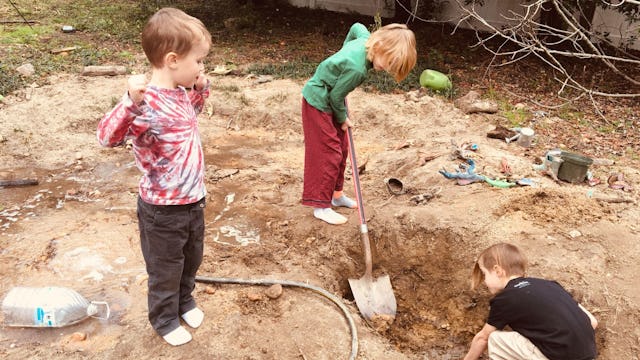Here's Why My Backyard Looks Like Hell (And I Don't Care)

My backyard will not be winning awards.
It’s mucky. It’s muddy. A huge swath of it has been reduced to packed bare earth. There is a large, shallow depression in it, and a small, deeper pit. The deeper pit goes down about two feet to the yellow-sand concretion so hard it took fancy equipment to dig our fence posts. There are scattered shovels of various sizes. There are plastic dinosaurs. There are lost muck boots and footprints and tufted vegetation that’s been raided for its leaves. Sometimes, you know, you need to made some fake soup. A hose lies coiled amid everything.
“Mama,” my five-year-old will ask, in the middle of the afternoon, the morning, or right before the sun goes down, in all types of weather, “can we make a lake?”
And as long as it’s not too cold and wet, or just before dusk, we try to say yes. So three small boys tromp outside and merrily destroy the lawn: digging pits, building earthworks, pulling up plants, and generally playing in the dirt. They spend at least an average of an hour a day at this, usually two. My husband and I have long decided that we’d rather have happy children than a lush, green lawn.
Life in an apartment? You could try something similar with a water table.
Back yard covered in snow? Your kids can destroy your pristine lawn by making a snow fort, building snow men, and creating their own sculptures out of the white stuff.
All this play is child-directed and open-ended. In other words, there’s no adult standing over them telling them how to play their games, what their games should look like, what’s the right way to use that shovel and what’s the wrong way. They learn by doing. It’s also free play: they’ve chosen, over all their other toys and electronics (they do own a few electronics, I promise), to go outside and engage in this type of play. They have choices. Even if my kids have been ordered outside for reasons of hyperactivity, there are other things (like a ninja line and a geodesic dome) they can play with. Or, like kids everywhere, they can just try and flip each other over in the damn hammock. But every freaking time, they pick the dirt and mud.
This is actually a very good decision, according to science and multiple experts.
All play issues aside, according to Quartz, dirt has what’s called a microbiome, which mean it has its own unique jumble of bacteria and microbes. While they’ve proven that it doesn’t cure cancer (literally, they tried), they found that it does have much the same mechanisms as an antidepressant when injected into mice. Kids with early exposure to germs, science says, “help strengthen the immune system and protect children from developing allergies and asthma.”
So, while there’s no true method to our madness (other than child-led fun), it does have its health benefits too.
Basically, it’s really good for kids to get dirty, and not just get dirty, but actively get down in the dirt. You can get the same benefits from gardening on a micro-scale, so even planting things in pots —winter veggies like kale or carrots, for example —is great for kids. Or you could just let them dig in the dirt from the pots.
Stephanie Garst, the Executive Director of the US Play Coalition, also agrees that mud play is a great thing for my kids to engage in. “Squishing the mud through the fingers, smelling the unique aroma that can transport you back to that childhood moment even as an adult, hearing the squeals and laughter as your castle’s moat melts the castle and devolves into a mud fight, seeing the spectrum of colors and the broad grins of delight…those broad grins inadvertently tasting the mud as it splats against your cheek! Playing in the mud connects children with nature and improves their mood.” She also points out that mud is never just mud: it’s always a cake or a brick or something standing in for something else. It is, in sort, a substance of pure creation. The same, of course, applies to sand and snow.
Rebecca Holcombe, the Director of Community Programs at Common Ground, an Environmental Education Center in New Haven, CT, agrees with Garst. She says, “The mud kitchen on our campus is a popular spot in all seasons … We see toddlers and preschoolers enjoying the mud kitchen as much as fourth and fifth graders … They practice fine motor skills as they pour water, they use their whole body to dig a big hole and mix mud, and they enjoy multi-age imaginative play when they start a restaurant and take orders for mud cakes and dirt soup.”
In short, dirt makes for great imagination. So do sand and snow. In general, outdoor free play is just great for kids.
So, my lawn can go to hell. My kids are happy and engaged with the world. They’re inhaling needed microbiomes, probably eating them, using their imaginations and their problem-solving skills (especially as they try desperately to keep all that water from flowing out of their hole).
At the very least? There’s less grass to mow.
This article was originally published on